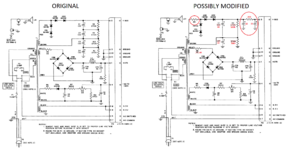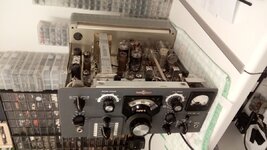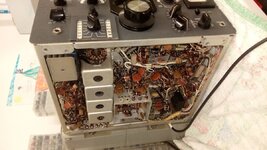neazoi
Advanced Member level 6
Hi, I have a low transmit power on all bands, apart from 40m, on a Collins KWM-2A transceiver with a PM-2 PSU.
I have done alignment of the RF circuits but it did not help the problem.
I have checked the voltages of the PSU. 275v is 265v, bias is ok, heaters are ok, unloaded (RX mode) HV is around 900v. Unfortunately I am unable to measure loaded (TX) HV.
I measured the voltages in the final tubes grids (pin 5, at C127) both on TUNE and on LOCK.
The second column is for TUNE and the third for LOCK
80m 145pvv 100vpp
40m 150vpp 100vpp
20m 145vpp 100vpp
On LOCK I get lower RF grid voltages than on TUNE. Maybe this is normal (loading of the driver plate) maybe not.
In the possibility that the PM-2 may be the problem and not be able to supply the HV current needed under load (so anode voltage drop), I investigated this PSU issue a bit. My PM-2 seems modified. I do not know if this was a modification that Collins did, but it is not the same as the schematics.
What I know for sure is that someone has been in there cause it was recapped on 1997 (there is a note in it)
Under load (PTT) I am unable to measure the anode voltage of the finals (not a suitable meter), so I do not know if the PM-2 is loaded.
Here is the original schematic of the PM-2 and here are the modifications in my PM-2.
As you can see, an extra RC filtering state has been added in the HV, the capacity of the first filtering stage has been reduced to more than half, and an extra resistor was added prior to the diodes.
Note, I mentioned in a previous email that I did a swap on the 20R and 40R resistors, so that to bring the voltages close to 275V (265v now).
Maybe I should undo the modifications that the previous owner had (possibly) done and build the PSU as the manual states?
I fear that this 200R may limit the current to the finals and so, drop the voltage.
Although on 20m, where I get only 45-50W, the plate current reads 230mA.
What do you think?
By the way, why are these resistors are used between the transformer and the diode rectifiers?
Is it safe to remove them? In the HV line there is no such resistor in the original schematic.
I have done alignment of the RF circuits but it did not help the problem.
I have checked the voltages of the PSU. 275v is 265v, bias is ok, heaters are ok, unloaded (RX mode) HV is around 900v. Unfortunately I am unable to measure loaded (TX) HV.
I measured the voltages in the final tubes grids (pin 5, at C127) both on TUNE and on LOCK.
The second column is for TUNE and the third for LOCK
80m 145pvv 100vpp
40m 150vpp 100vpp
20m 145vpp 100vpp
On LOCK I get lower RF grid voltages than on TUNE. Maybe this is normal (loading of the driver plate) maybe not.
In the possibility that the PM-2 may be the problem and not be able to supply the HV current needed under load (so anode voltage drop), I investigated this PSU issue a bit. My PM-2 seems modified. I do not know if this was a modification that Collins did, but it is not the same as the schematics.
What I know for sure is that someone has been in there cause it was recapped on 1997 (there is a note in it)
Under load (PTT) I am unable to measure the anode voltage of the finals (not a suitable meter), so I do not know if the PM-2 is loaded.
Here is the original schematic of the PM-2 and here are the modifications in my PM-2.
As you can see, an extra RC filtering state has been added in the HV, the capacity of the first filtering stage has been reduced to more than half, and an extra resistor was added prior to the diodes.
Note, I mentioned in a previous email that I did a swap on the 20R and 40R resistors, so that to bring the voltages close to 275V (265v now).
Maybe I should undo the modifications that the previous owner had (possibly) done and build the PSU as the manual states?
I fear that this 200R may limit the current to the finals and so, drop the voltage.
Although on 20m, where I get only 45-50W, the plate current reads 230mA.
What do you think?
By the way, why are these resistors are used between the transformer and the diode rectifiers?
Is it safe to remove them? In the HV line there is no such resistor in the original schematic.



